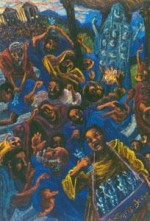
On Tuesday September 30 of last year, painter Simon Carr came to speak in the Fine and Performing Arts Center’s lecture room. He spoke mostly about his most recent Subway paintings, their meaning to him and their formal aspects.
The next day, I had the chance to sit down and speak with Carr a little more in depth about his figurative paintings, his career as an artist and his perspective on life. Carr is certainly an interesting and friendly guy, well connected and in touch with the people of New York. Carr could even be called a humanitarian, a Christian and a pragmatist, as well as an artist.
The last century has seen a strange shift in the role art plays in peoples’ lives. We have seen more and more art schools popping up all over the world, more students enrolling in art schools and getting art degrees. Yet for many people not plugged in to the art world, contemporary art either means Thomas Kinkaid’s mass produced landscapes, practically oozing with saccharine sunlight, or something detached, strange, esoteric and even insulting.
In the early/mid 1900’s, we began to see a shift to surrealism and abstraction in the art world because artists were fed up with academic realism, artistic rules or tradition, and the use of beauty as the connection to divinity. Art on the whole became more of a closed language, inaccessible to those who were not willing to reason why art had taken this turn and what it meant. To many, though this was a significant and important point in the history of art, it was an insult to everything art had accomplished since early humankind began drawing figures on cave walls. It was as if artists had thrown it all out the window, and were starting back at the caves again.
At this point, the pendulum is swinging back a bit, and people are craving a more direct human connection in the art work they see. Art will never fully return to traditional figure, landscape or portrait painting, but there is a growing niche in the art world. It is a backlash from pure abstraction. Art is in many different ways and approaches, getting more personal, more inviting to the viewer.
Carr, deeply respectful of the old masters and of early modernists, paints in a way that is at once relevant in contemporary art, but that also speaks to just about any viewer. His colorful paintings juxtapose the fresh, clean geometry of New York subways to the organic shapes of human and animal figures, in a way that seems very natural. Similarly, the cool cobalt blue that often dominates his subway paintings juxtaposes the friendliness of figures, children and animals moving through the subways and over the platforms.
Commenting on the way many people see contemporary art, as being detached and elusive, Carr says that “I think their intuition is right about that. I don’t mean to set myself up as a populist, I’m not trying to pull a Thomas Hart Benton. On the other hand, I think people deserve to be communicated with.” Carr does not intentionally paint to appease the appetite of people, it comes naturally out of his desire to paint the figure. “When I started the subways, part of it started naturally because I was working with crowd scenes and I began looking at the subway and the geometry was very attractive and the perspective…but the other reason was I knew this was because I knew it [the subway] was a fundamental experience to anyone who lives in New York. And apparently, the group experience too.”
While Carr was painting the subways, he was also experiencing a unique connection with his fellow New Yorkers, as these paintings began just before the 9/11 incident, which changed the way Carr developed them. Carr states that “9/11 changed the way the New Yorker understood New York, in a good way. Not because it was scary, not because we were attacked, a phrase I hate, but because of the way people reacted to what happened. You just can’t believe what happened in lower Manhattan. Everybody went down town. Everybody wanted to help…we were so desperate to help, we were making peanut butter sandwiches for cops in the basement of a local church…there’s something in the subway pictures that has to do with that, that has to do with the condition of being human in contemporary life, the condition of being in a group in contemporary life, the condition of being amongst others, in some interrelated way.”
I asked Carr how he felt his paintings related to the current condition of humanity. He replied by using the metaphor of humanity, riding on a speeding train, though he was reluctant to use it because he felt it was cliché. He said that in terms of the moment, in terms of the group experience of the moment – and what could be more present tense than that – that sense of travel and that sense of being thrust with a group of people and suddenly finding yourself in motion. I think it could be useful, especially at this point, when history has gotten completely out of control, or we’ve lost the illusion that we’ve had any control of contemporary events at all. It seems like a useful metaphor. Carr’s paintings, though not paintings of people in speeding trains, are of people congregated in groups in or around subway stations.
They accentuate that feeling of fleeting moments, of change and displacement. They embrace the temporal quality of our daily lives. One moment, you may be speaking with your mother on your cell phone who lives in another state. You may be standing on the subway platform. You hang up the phone, get on the subway, and 10 minutes later, you’re on the other side of the city. Mean while, dozens of other strangers around you make their own choices, their own transitions. Carr’s paintings encapsulate this post-modern feeling of movement and speed, yet they also state that we’re all in it together.
Thinking of my own future, and the futures of my fellow art students, I asked Carr how he would define artistic success. He replied that “Most artists don’t make a living off their work. They teach, some people do other things. Teaching is really the most common way because you’re still in the business in a sense, you’re talking about what you know how to do, you’re talking about what you love. So, that leaves the definition of success a little bit more open. I used to have a friend who said ‘if you’re working and you’re not dead, you’re succeeding.’ As long as you’re working you’re s ucceeding. As long as you’re still interested, and alive and making pictures. I think you’d have to be a little bit more adventurous than that, and say, if you’re working and showing [your work] and you’re part of a community of artists, it’s a very fulfilling and exciting life. The money comes second I think. And there are a lot of opportunities to make money.”
When I spoke with Carr about multi-media entertainment taking over the sphere of people’s lives that art used to inhabit, he replied that while that kind of entertainment asks nothing of you, painting asks everything of you, and gives even more. “The media world we’re confronted with asks nothing of us except slack-jawed attention, I mean really, your mouth can be open, and you can be drooling, for most of the things that come across the TV or radio or anything like that, and that’s not what art is at all.
“It requires huge emotional investment, huge intellectual investment, and the reward is enormous, and I think it stands in high contrast to that other.”






